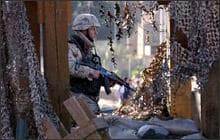Advertisement
Post-War Dreams and Delusions
Resume Four U.S. troops were wounded in Iraqi insurgent attacks yesterday. More than 450 U.S. troops killed since fighting began. Iraq collapsed to American missiles and troops, but post-war planning hasn't gone smoothly.
Four U.S. troops were wounded in Iraqi insurgent attacks yesterday. More than 450 U.S. troops killed since fighting began. Iraq collapsed to American missiles and troops, but post-war planning hasn't gone smoothly.Much of Iraq is devastated, its national treasures looted and its infrastructure in shambles. Resistance to the U.S. occupation, however, is strong. In his article "How Post-War Planning Bit the Dust," Atlantic magazine national correspondent James Fallows asserts that Pentagon higher ups ignored the warning signs. While George Bush kept to the big picture, Dick Cheney, Donald Rumsfeld and Paul Wolfowitz, Fallows argues, pushed us head first into a conflict we knew how to enter, but not exit.
Tonight, On Point, a close-up look at the lofty dreams and heady delusions of post-war planning in Iraq.
Guests:
James Fallows, national correspondent for The Atlantic Monthly and author of the article, "How Post-War Planning Bit the Dust," in this month's issue
Conrad Crane, director, U.S. Army Military History Institute, Army War College, retired army officer and principal author of
"Reconstructing Iraq: Insights, Challenges and Missions for Military Forces in a Post-Conflict Scenario."
This program aired on January 6, 2004.